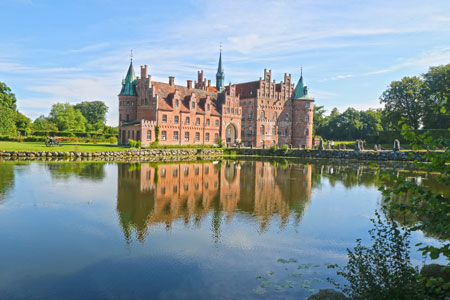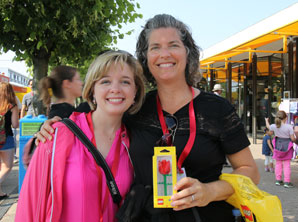10/28/2015
The “havecenters” of Denmark
Chris Beytes

Denmark was the destination of the 2015 International Garden Center Association Congress and Green Profit was there with 170 attendees (including 15 Americans and 18 Canadians) from 20 countries to enjoy the five-day tour. Stops included 11 garden centers, four gardens, three castles, a commercial greenhouse, a turf seed producer, a Danish design trade fair, an art museum, a nursery marketing association, a flower festival and, of course, the original Legoland.
Pictured: Egeskov Castle, one of several historic and scenic non-garden center stops on the IGCA tour.
This was
Green Profit’s fifth IGCA Congress since 2005, and by far the most strenuous, at least from an early-to-rise, late-to-bed point of view. Denmark isn’t a big country—16,600 sq. miles, about the same as Washington State—but it’s spread across a peninsula that’s attached to the top of Germany (Jutland) and two large islands to the east (Funen and Zealand). The organizers wanted us to experience garden centers in all three regions, which meant lots of bus time from our base at Odense on Funen. But hey, we got to drive across the Great Belt Bridge, the third-longest suspension bridge in the world (0.99 miles)!
This Scandinavian country is home to 5.7 million happy* people … and Hans Christian Anderson, from whom you can’t escape, especially in his hometown of Odense. Hans is their leading industry. We lodged in the H.C. Anderson Radisson, toured his (supposed) home and enjoyed an H.C. Anderson impersonator who made appearances at both the opening and closing dinners.
Beyond Hans, it’s agriculture. Outside of the cities of Copenhagen and Odense the countryside is extremely rural and covered by endless acres of wheat and canola fields. Flowers also play a big part in the agricultural economy, with some of Europe’s best and most innovative greenhouses located around Odense. Potted plants rule, especially windowsill-sized. We dined at PKM, the world’s biggest campanula grower, where they produce 20 million pots per year.
But on to the garden centers, or “havecenters” as they call them. Of the 11 we visited, I would describe 75% of them as “typical”—the sort of building, layout, fixtures, design and curb appeal you’d see in any state in America. Clean, organized and decently stocked, but nothing to write home (or a magazine article) about.
They have the same general plant, garden and accessories departments you’d see in the U.S., as well, along with some home décor, some pet, some clothing and some gourmet food. But certainly not the expansive displays of those categories one finds in the UK, for instance. And no cafés except in a few instances and offering only simple fare. These are plant centers, with the emphasis on plants. In fact, many have “planteskole” (nursery) in their name. Roses, in particular, are popular. One center, Laubjerg’s Planteskole in Odense, not only in specializes in roses, but also has an extensive “rosenhaven” (rose garden). Another hosted a two-hour rose giveaway while we were visiting; customers and carts were queued up practically around the block.
Overall, we found the average Danish center to more resemble those in North America than Europe, with two exceptions: plant quality and restrooms. Because of the proximity to major European plant auctions, plant quality and selection ranks as superb, especially indoor plants. We in North America simply don’t enjoy the supply chain they do.
But one thing we tend to do better is restrooms. Even at the largest, newest centers, the Danes seem to treat public facilities as an afterthought.
Now for a few highlights: Of the 11 garden centers, three stuck out as above average, one for its “Danishness,” one for its atmosphere and details, and one for sheer size.
Danishness—meaning sleek and modern, with minimalistic fixtures—is what we expected to find much of, but didn’t. Except at HaveOasen (“garden oasis”), which combined a modern building with a hip gray color scheme and trendy metal fixtures. Oddly, it also had the most quaint outdoor plant area. Yet the fixture, built from rough-sawn, wavy-edged timbers, were some of the most effective we’ve seen at any garden center.
For atmosphere, we all liked Skraedderbakken Havecenter. The long entrance walk had the serenity and fine details of a Japanese garden. Then we were greeted by the bright eyes, lolling tongue and wagging tail of Molly, the resident Berner, who posed for petting and pictures with a statue of herself.
The center is built upon a slight slope, which some attendees thought was a negative, but I liked the scenic vistas it offered. The outdoor area was neatly divided into rooms by Asian-inspired fencing and tidy hedges. In fact, we saw more effective and attractive hedging in Denmark garden centers than anywhere else—a sure sign that they can offer good advice on your own hedges. Skraedderbakken is a three-time garden center of the year award winner in their size category.
For size, Plantorama’s name says it all. At 100,000 sq. ft., the flagship of the eight-store Plantorama chain is the largest IGC in Scandinavia. As one attendee joked, “They didn’t name it Auntie’s Little Corner Shop.” The stunning structure makes quite the impact when you arrive. Yet despite its big-box size, they managed to bring down the scale of the place effectively using fixtures, signage and other techniques. You could find a little bit of everything at Plantorama, in good quality and a range of prices, including very high. How about a $750 koi?
The above visits were interspersed with some of the most beautiful public and private castle gardens we’ve ever seen. Then there’s famous Tivoli Gardens in Copenhagen, which we visited on our own before the tour. Interesting food, great scenery, a mild climate, welcoming hosts and convivial fellow travelers … all combined for another great IGCA Congress.
Want to experience an IGCA tour for yourself? Mark your calendar for August 21-26, 2016, when we visit the garden centers of Switzerland. Hope to see you there!
www.intgardencentre.org.
 Spartans Go Danish
Spartans Go Danish
Sporting a flower find at Legoland are Heidi Wollaeger and Kristin Getter, two Michigan State University graduates and now educators, who joined 13 other Americans on the IGCA tour of Denmark. Heidi (left) is a greenhouse and nursery extension educator, working with southwest Michigan greenhouse growers and southern Michigan nursery growers. Kristin has been working with eastern Michigan growers and retailers for more than three years and now has a 100% teaching appointment at the school.
Why come on an IGCA tour? “Our idea was to take ideas that we saw on this tour and tell our growers and retailers about it, as a way to help them expand their businesses,” says Heidi. They funded the trip through scholarships, program-generated revenues, private research and other means. No taxpayer dollars were used, Kristin added.
Was it worth the cost? Absolutely, says Heidi. “I really enjoyed seeing the different ideas, the European model is very different, the market is different … it’s fun to learn about.” Her favorite find? “I loved the hedges that separate departments. Sort of making rooms out of it.” Kristin liked the botanical garden-style display gardens at one center.
The pair added that meeting garden center owners and managers from 20 different countries is equally as valuable as the tour itself.
“We may be more experts in the science, but they’re more practical in how to run a business, says Kristin.
GP
 Pictured above: One of the favorite stops on the trip was Skraedderbakken Havecenter. Not just for Molly the Bernese mountain dog (who has her own statue), but for the inviting Japanese-inspired entryway and the neatly hedged and fenced sales area. Some thought the sloped site was a detriment to customers; we liked the vistas it offered. Tables have adjustable legs to handle the hill.
Pictured above: One of the favorite stops on the trip was Skraedderbakken Havecenter. Not just for Molly the Bernese mountain dog (who has her own statue), but for the inviting Japanese-inspired entryway and the neatly hedged and fenced sales area. Some thought the sloped site was a detriment to customers; we liked the vistas it offered. Tables have adjustable legs to handle the hill.

Pictured above: “Garden Oasis” was, in our opinion, the most “Danish” of the Danish garden centers, with a sleek design, monochromatic color scheme and modern display tables. Yet interestingly, their nursery area featured tree supports that were as rustic—and as effective—as any we’ve seen.